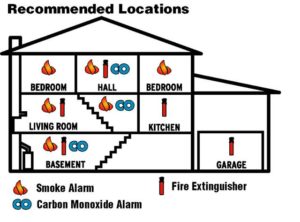October Safety Tip
Fire Safety Tips
How can I protect against fire?
Fire is a deadly threat to any household. It can strike anywhere, at any time. You must be prepared by using the tools for fire protection.
Smoke alarms provide a warning of fire. Smoke alarms are the easiest, most cost-efficient way to alert your family of a developing fire. The more smoke alarms you have installed in your home, the more your chances increase that you will be alerted to a fire.
Fire extinguishers provide a tool to fight small fires. Having a fire extinguisher in your home can increase your chances of keeping a small fire from getting out of control and becoming a deadly rage.
Using both smoke alarms and fire extinguishers in your home, along with knowing what to do in case of fire, can help save your life!
I have one smoke alarm in my home. Is that enough protection against fire?
No, several smoke alarms and fire extinguishers must be installed and maintained for proper fire protection. The NFPA recommends smoke alarms be installed on every level of the home, and inside every bedroom and sleeping area. Smoke alarms should also be installed in the main corridor outside each bedroom area. Fire extinguishers should be installed on each living level, as well as in rooms that pose potential fire hazards (i.e., kitchen, garage, and workshop).
Installing and maintaining smoke alarms and fire extinguishers dramatically increases your family’s chances of surviving a fire.
Other important considerations include:
- Mount smoke alarms in the middle of the ceiling when ceiling mounted. If that is not possible, mount detectors on the wall at least three feet away from a corner and 4 – 6 inches away from the ceiling.
- Keep smoke alarms away from drafts created by fans or air ducts. The moving air can blow smoke away from the sensor.
- Avoid placing smoke alarms too near the kitchen stove and bathroom shower, as cooking smoke and shower steam can cause nuisance alarms.
- Mount fire extinguishers on a wall 3 1/2 to 5 feet above the floor. The location should be near an exit or an escape route from the room.
What types of smoke alarms are there?
There are two basic types of smoke alarms: ionization and photoelectric. Both are effective at detecting smoke, yet each has a unique detecting system.
- Ionization technology is generally more sensitive than photoelectric technology at detecting small particles which tend to be produced in greater amounts by flaming fires, which consume combustible materials rapidly and spread quickly. Sources of these fires may include paper burning in a wastebasket, or a grease fire in the kitchen.
- Photoelectric technology is generally more sensitive than ionization technology at detecting large particles, which tend to be produced in greater amounts by smoldering fires, which may smolder for hours before bursting into flame. Sources of these fires may include cigarettes burning in couches or bedding. Each type of detector also comes as AC-operated smoke alarms or battery-operated smoke alarms. Some AC alarms even come with a battery back-up system. Additional options can include an escape light, silencing button, or remote control mute feature.
What types of fire extinguishers are there?
Fire extinguishers are categorized by ratings. These ratings determine the size and type of fire that the extinguisher can successfully put out. Fire can be divided into three categories: A, B, or C. An “A” type fire is primarily wood, paper and fabric. “B” type fires are primarily flammable liquids (such as gasoline) and oil based. Finally, “C” type fires are electrical in nature.
The number preceding the A, B, or C rating determines how big of a professionally set fire the extinguisher can put out. For example, a 10-B:C extinguisher would be able to handle a 25 foot square fire of either flammable liquid or electrical origin. A 5-B:C extinguisher could handle a 12.5 square foot fire that is flammable liquid or electrical based.
What should I do if I hear the smoke alarms sound?
NEVER IGNORE THE SOUND OF A SMOKE ALARM. If the smoke alarm is sounding its alarm, there is a reason. You and your family must be able to escape quickly and safely. Here are several steps your family can learn and rehearse for an emergency:
- Have an escape plan. Discuss and practice your escape plans. Know two exits from any room in the house.
- Feel if the door is hot. Always feel the door to see if it is hot before opening It to escape. If the doorknob or door is hot, do not use that exit. Use your alternate exit to escape.
- Crawl on the floor. Smoke from a fire rises and so does the temperature. If you crawl on the floor there will be less smoke and the heat from the fire will be less severe.
- Meet at a prearranged spot outside the home. If you clearly show where everyone is supposed to meet outside the home when there is a fire, it will be easier to know who is safe.
- Call the fire department from a neighbor’s home. Be prepared to give your full name and address to the operator at the other end of the line. Stay on the line until the operator has all of the information needed.
- Never go inside a burning building. Never return inside the house for any reason. The firefighters will be there soon.
If you follow these basic fire safety tips, you will increase your family’s chances for survival in a fire.
Are there other ways I can protect my family from fires?
The following is a fire safety checklist to lower the chances that a fire may start in your home:
- Keep the furnace in working order.
- Use a fireplace screen.
- Have proper ventilation for heaters and other small appliances.
- Do not smoke in bed.
- Use the correct size fuses.
- Don’t use worn out electrical wiring or run it under rugs or out windows or doors.
- Clear refuse away-the less clutter, the less fuel a fire has to feed on.
Tips for testing and maintaining smoke alarms
- The National Fire Protection Association recommends testing your smoke alarms at least once a month.
- Make sure everyone in the home understands the sound of a smoke alarm and how to respond.
- Follow the user manual instructions for cleaning and maintaining smoke alarms for proper functionality.
- Smoke alarms require a new battery at least once a year or if a low battery chirp occurs.
- Smoke alarms should be replaced every 10-years.
- Smoke alarms with a 10-year sealed battery should be replaced once it exceeds its life expectancy or if a low battery chirp occurs.
- When replacing a battery, follow the user manual which includes a full list of approved batteries.
- Smoke alarms should be maintained according to the user manual.
- All First Alert user manuals are located on www.firstalert.com within each product page.
- The NFPA recommends smoke alarms be installed on every level of the home, including the basement.
- Plan and practice an escape route with your family. If there is an emergency, everyone will know how to exit the home safely and where to meet.
October 2018 Safety Tip: Fire Safety Tips

